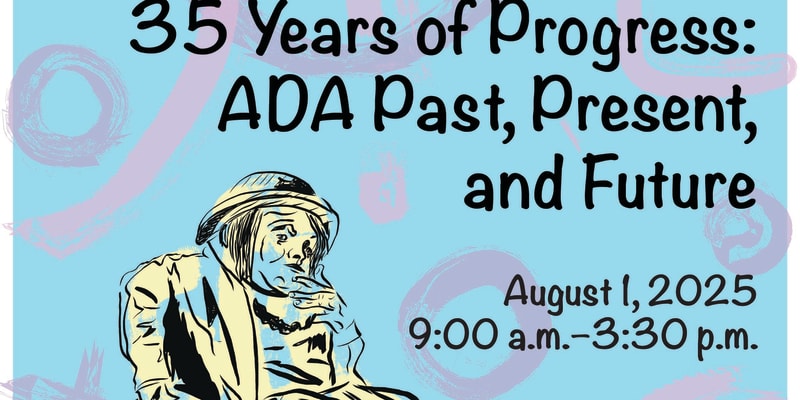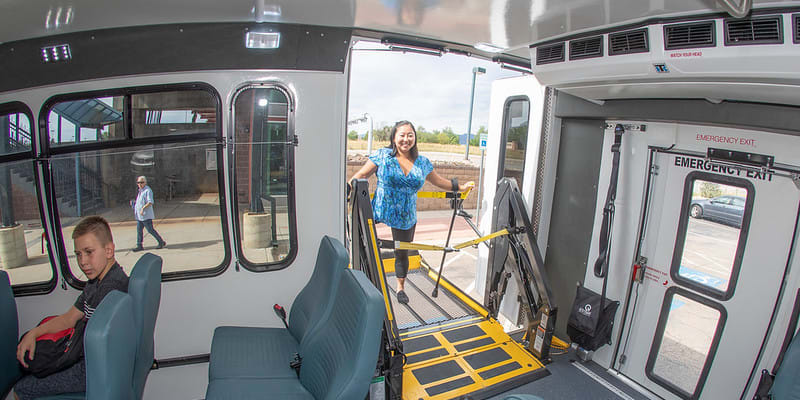Americans with Disabilities Act Office

Americans with Disabilities Act Office
The Americans with Disabilities Act (ADA) Office oversees RTD's compliance with Titles II and III of the ADA, which prohibits discrimination based on disability and requires RTD to make the agency’s public transportation system accessible to persons with disabilities. The ADA Office manages the reasonable modification process; monitors agency services and programs to safeguard compliance with federal standards; investigates ADA-related complaints; and provides guidance on policies, procedures, and strategies to protect the civil rights of people with disabilities.
Complaint Processing and Appeals
Please submit your complaint to RTD Customer Care by completing RTD's complaint form or call 303-299-6000 [TTY: Dial 711]. Language assistance is available at no cost. For Spanish, please press 2. For all other languages, press 8.
Please be sure to communicate whether your complaint is related to your disability and provide sufficient facts demonstrating how your complaint is related to your disability. You will receive an automatic acknowledgment of receipt within three business days, provided an email address was submitted.
Under Title II of the Americans with Disabilities Act (ADA), RTD is required to make its services and programs accessible to people with disabilities and in compliance with the ADA. This procedure satisfies RTD’s obligation to provide a grievance procedure under Title II. If you feel that you have not been able to access a program or service of RTD because of accessibility issues, or have been discriminated against based on your disability, you may submit an ADA Complaint to RTD Customer Care. RTD Customer Care is the point of contact for all RTD comments and complaints.
Any person who believes that they have been discriminated against on the basis of disability by RTD may file an ADA complaint, by submitting a complaint to RTD Customer Care.
Effective Communication
RTD will take the appropriate steps to ensure that communication with applicants, participants, and members of the public with disabilities is effective. RTD shall furnish appropriate auxiliary aids and services where necessary to afford a person with a disability an equal opportunity to participate in RTD programs and services.
Request for Information in Alternative Formats
If you cannot access the information contained within a document due to its format. RTD will take the appropriate steps to ensure communication with applicants, participants, and members of the public with disabilities is effective. RTD shall furnish appropriate auxiliary aids and services where necessary to afford a person with a disability an equal opportunity to participate in RTD programs and services.
To help RTD respond in the most helpful way, please include the nature of your accessibility concern, the format in which you prefer to receive the material, the web page address of the requested material, and the best way to contact you. Please contact Gabe Christie, ADA Manager, with your request and allow a minimum three business-day notice for arrangements to be made.
Reasonable Modifications
In accordance with the ADA and directives from the Federal Transit Administration, RTD will make efforts, to the maximum extent feasible, to ensure that a person with a disability has access to, and benefits from, RTD services. RTD will make reasonable modifications to its policies, programs, and procedures applicable to its transportation services, when necessary to avoid discrimination and ensure accessibility for people with disabilities.
Please note: RTD may be unable to accommodate requests that would require fundamental alterations to the nature of RTD programs or services or would directly interfere with the health and safety of others. If the requested modification cannot be granted, but a barrier to access still exists, RTD will do its best to provide alternate access to our programs or services.
If you experience a barrier to accessing an RTD program or service, you may submit a request for a reasonable modification. A reasonable modification should be requested when our policies, programs, and procedures applicable to our transportation services do not allow a person with a disability access to the benefits of our service. The request must identify the modification needed to use the service. Whenever feasible, please make the request in advance, before the modification is needed to access the service. Within the scope of the ADA, and reasonable modification, if RTD denies a request it will make every effort, to the maximum extent feasible, to ensure that a person with a disability has access to, and benefits from, its services.
To request reasonable modifications based on a disability please use the Reasonable Modification Request Form, or contact RTD’s ADA Office for assistance. Phone: 303-299-2250 or email: [email protected].
Here is what you should expect when you submit an advance reasonable modification request with RTD:
- RTD will promptly and thoroughly review your request.
- Please allow at least five (5) to seven (7) business days to receive a response regarding your reasonable modification request.
- RTD staff will be in contact with you if any additional documentation is required or if there is an update about your reasonable modification request.
Accessibility Information
All RTD vehicles, including the Free MallRide, Free MetroRide, Access-A- Ride, Commuter Rail, and Light Rail vehicles have automated voice, display announcement systems, and are accessible for mobility aids such as wheelchairs, electric scooters, walkers, canes, and crutches. Bus and rail operators are trained to assist customers with disabilities with boarding, securing their device, finding a seat, and deboarding the vehicle. While securement should be offered to all customers it is not required and customers can decline it at their discretion.
RTD honors all reasonable requests for assistance. These may include (but not limited to):
- Kneeling the bus, deploying ramps or bridge plates to board or exit vehicles
- Providing directions to navigate stations
- Providing assistance finding a seat
- Securing mobility devices, when requested
- Providing assistance about fares and some routing information
- Providing assistance with placing monies in the fare box in situations where a customer cannot reach or insert a fare into the fare box
Commuter rail vehicles are wheelchair accessible with level boarding at every door and designated mobility device seating areas on every vehicle. Securement is not required or assisted. The designated mobility device area is adjacent to every door on every rail car. If the designated area is full, please travel to another door area by exiting the rail car and entering another door on the rail car. The operator stays in the cab and will not assist with boarding/deboarding the vehicle. The on-board Transit Safety Officer (TSO) may be available for assistance but is not required to assist riders using mobility devices, passengers boarding with strollers, and/or large items.
RTD employees will never ask about the nature of your disability. People with non-apparent disabilities are not obligated to share that information to use accessibility equipment or features.
Related Articles
Accessibility Information
On-the-Spot Modifications
Per FTA Regulations the following two examples are plausible reasonable modification requests.
Obstructions
For fixed-route services, a passenger's request for a driver to position the vehicle to avoid obstructions to the passenger's ability to enter or leave the vehicle at a designated stop location, such as parked cars, snowbanks, and construction, should be granted so long as positioning the vehicle to avoid the obstruction does not pose a direct threat. To be granted, such a request should result in the vehicle stopping in reasonably close proximity to the designated stop location. Transportation entities are not required to pick up passengers with disabilities at non-designated locations. Fixed route operators would not have to establish flag stop or route-deviation policies, as these would be fundamental alterations to a fixed route system rather than reasonable modifications of a system. Likewise, subject to the limitations discussed in the introduction to this appendix, paratransit operators should be flexible in establishing pick up and drop off points to avoid obstructions.
Fare Handling
A passenger's request for transit personnel (e.g., the driver, station attendant) to handle the fare media when the passenger with a disability cannot pay the fare by the generally established means should be granted on fixed route or paratransit service (e.g., in a situation where a bus passenger cannot reach or insert a fare into the fare box). Transit personnel are not required to reach into pockets or backpacks in order to extract the fare media.
Appeal Process for an ADA Complaint
If you are dissatisfied with the result of your ADA complaint, you may submit your appeal to RTD’s ADA Manager by completing this online fillable appeals form. You must submit an appeal within 30 calendar days after you received your results or after you originally submitted your complaint, whichever is later. The appeal must be in writing and state all facts and arguments supporting your belief that the complaint was not appropriately resolved. The ADA Manager will review the complaint and provide a written response within 30 calendar days.
For an alternative format to file your ADA Appeal, please contact the ADA Manager, Gabe Christie at [email protected]. RTD will retain your complaint, appeal and response for at least one year.
For organizations or businesses outside RTD’s responsibility please contact the U.S. Department of Justice at 1-800-514-0301.
Accessible Facilities
All RTD Park-N-Rides locations and stations are ADA accessible. Elevators are present where necessary, as well as ramps to reach boarding platforms, truncated domes for safety, accessible parking spaces and curb cuts. RTD Ticket Vending Machines (TVMs) and validators contain braille and have audible announcements.
In the event of an elevator outage, information will be posted online under Service Alerts and at stations. Passengers can sign up to receive email notifications of these outages at the service alerts page.
Use of Accessibility Equipment
Every customer has the right to use accessibility equipment at RTD stations and on vehicles. Including, but not limited to:
- Ramps, bridge plate, and lifts
- Elevators and escalators
- Accessible gates

